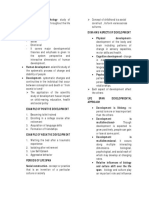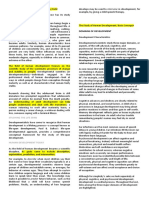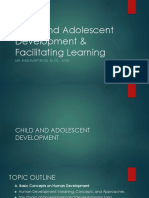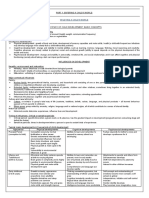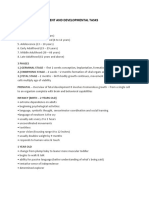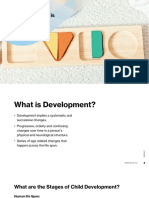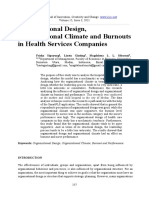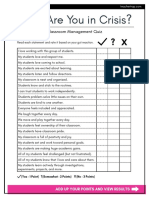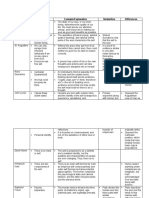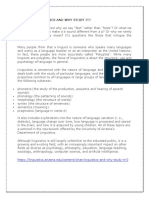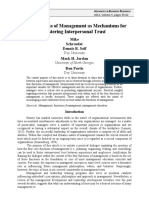Developmental process
Lusi Nurhayati
�Developmental processes
Quantitative :
Change in number or amount, such as growth or
loss in height or weight, gains in vocabulary, or
an increase or decrease in frequency of
aggressive behavior or social interaction
Qualitative
Change in kind, structure, or organization,
marked by the emergence of new phenomena
that cannot be easily anticipated on the basis of
earlier functioning, such as the change from a
nonverbal child to one who understand words and
can communicate verbally, a change of careers,
or the laerning of a new skill, such as the use of
computer.
�3 major domains of change
and stability
Physical development
Cognitive development
Psychosocial development
�Physical development
Growth of body and brain, sensory
capacities, motor skills, and health
�Cognitive development
Change and stability in mental
abilities, such as learning, attention,
memory, language, thinking,
reasoning, and creativity
�Psychosocial development
Change and stability in emotions,
personality and social relationship
this can affect cognitive and social
functioning
�Typical major development in 5
periods of child development
Prenatal period (conception to birth)
Infancy (toddlerhood birth to age 3)
Early childhood (3 6 years)
Middle childhood (6- 11 years)
Adolescence (11 to about 20 years)
Young adulthood (20-40 years)
Middle adulthood (40-65 years)
Late adulthood (65 years and over)
�1.Prenatal period (conception
to birth)
Physical developments:
conception occurs by normal fertilization or
other means;
the genetic endowment interacts with
environmental influences from the start;
basic body structures and organs forms: brain
growth spurt begins;
physical growth is the most rapid in the life
span;
vulnerability to environmental influences is
great.
�cont
Cognitive developments :
abilities to learn and remember and
to respond to sensory stimuli are
developing
Psychosocial developments:
Fetus responds to mothers voice and
develop a preference for it
�2. Infancy (toddlerhood birth to
age 3)
Physical developments
All senses and body systems operate
at birt to varying degrees
The brain grows in complexity and is
highly sensitive to environmental
influence
�Cont.
Cognitive developments
Abilities to learn and remember are
present, even in early weeks
Use of symbols and ability to solve
problems develop by end of second
year
Comprehension and use of language
develop rapidly
�Cont.
Psychosocial developments
Attachment to parents and others
form
Self awareness develops
Shift from dependence to autonomy
occurs
Interest in other children increases
�3. Early childhood (3 6 years)
Physical developments
Growth is steady; appearance
becomes more slender and
proportions more adultlike
Appetite diminishes, and sleep
problems are common
Handedness appears; fine and gross
motor skills and strength improve
�Cont.
Cognitive developments
Thinking is somewhat egocentric, but
understanding of other peoples
perspectives grows
Cognitive immaturity results in some
illogical ideas about the world
Memory and language improve
Intelligence becomes more predictable
Preschool experience is common. And
kindergarten experience is more so
�Cont.
Psychosocial developments
Self concept and understanding of emotions
become more complex; self esteem is global.
Independence, initiative, and self control increase
Gender identity develops
Play becomes more imaginative, more elaborate
and usually more social
Altruism, aggression, and fearfulness are common
Family is still the focus of social life, but other
children become more important.
�4. Middle childhood (6- 11
years)
Physical developments
Growth slows
Strength and athletic skills improve
Respiratory illnesses are common,
but health is generally better than at
any other time in life span.
�Cont.
Cognitive developments
Egocentrism diminishes. Children
begin to think logically but concretely
Memory and language skills increase
Cognitive gains permit children to
benefit from formal schooling
Some children show special
education needs and strengths.
�cont
Psychosocial developments
Self concept becomes more complex,
affecting self-esteem
Coregulation reflects gradual shift in
control from parents to child
Peers assume central importance
�5. Adolescence (11 to about 20
years)
Physical developments
Physical growth and other changes
are rapid and profound
Reproductive maturity occurs
Major healthy risks arise from
behavioural issues such as eating
disodders and drug abuse
� Cognitive developments
Ability to think abstractly and use
scientific reasoning develops
Immature thinking persists in some
attitudes and behaviors
�cont
Psychosocial developments
Search for identity, including sexual
identity, becomes central
Relationships with parents are
generally good
Peer group ay exert a positive or
negative influence.

